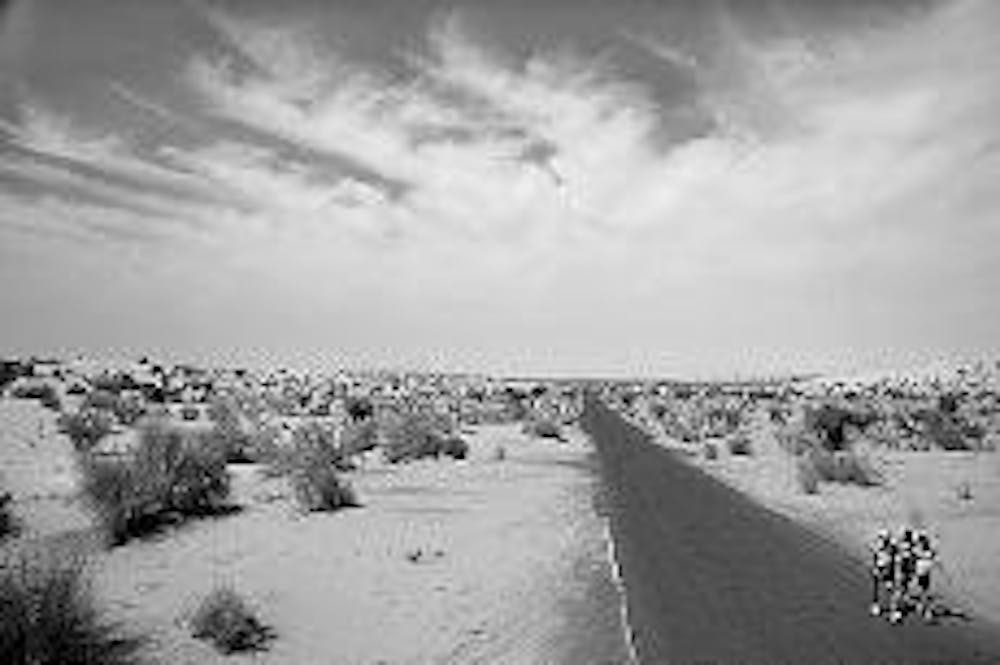When three men decided to run through the Sahara desert, one of the most unforgiving places in the world, the chances of all three making it across were virtually nil. But in this revealing and inspiring documentary, odds mean nothing when the runners are pushing themselves to show us the importance of Earth's most vital resource.
It's hard to believe three men could succeed in a quest to run across the Sahara desert, over 4,300 miles, in just 111 days. But "Running the Sahara," a documentary that chronicles the expedition, proves that it can be and has been done. The film was shown at the AFI Silver Theatre in Silver Spring, Md. on Thurs., March 26. "The odds of all three of us making it all the way across were almost zero," said 46-year-old adventurer Charlie Engle of himself and his running mates in an interview with The Eagle. Engle spearheaded the expedition.
"The idea just came to me one day on run and it just took off from there," he said.
The runners faced physical, political and logistical challenges. They ran a distance equivalent to almost two marathons every day in 140-degree heat and extreme desert sand storms.
Ray Zahab, 42, from Canada and Kevin Lin, 28, from Taiwan joined Engle as runners. Academy Award-winner Matt Damon narrated and produced the documentary and James Moll served as director. It cinematically follows the runners from their pre-departure predictions to the final day, and is now available on DVD through National Geographic.
The runners began their journey on Nov. 6, 2006, in St. Louis, Senegal, and ended at the Red Sea outside of Cairo 111 days later. The team crossed through Senegal, Mauritania, Mali, Niger, Libya and Egypt on their way. The runners made the decision to run through Libya, even though the country is unaccustomed to Western visitors, because of the dangerous and volatile regions in Chad and Algeria.
"We didn't gain permission to get into Libya until two days before we got there," Engle said. "Once they realized we were harmless and not trying to make any political statement they decided to let us in."
While traveling through Africa, the group realized the depth of water issues in the Sahara. They highlight these issues throughout the documentary after seeing how vital water is to this region. They stop when they find a young child alone in the desert while his parents are traveling miles to get water.
"I wanted to run the Sahara first and foremost as a personal quest, however the documentary was a vehicle to raise money for an important issue," Engle said.
Engle, who has been a runner for 30 years, also worked recently as a producer on "Extreme Makeover." However, he said, running and adventure came first for him. After kicking a drug and alcohol addiction, he ran more than 50 marathons and then started to enter ultra-distance marathons.
"I ultimately began to search for longer and longer distances and self-made adventure, which is where the Sahara came in," Engle said.
Engle said that he used these long distance races as a mechanism of self-healing and maturing. "The most human growth comes from the most difficult situations that we face. I put myself in a position of suffering because I believe that physical suffering brings about emotional transformation," he said.
During the film, Engle argues with the trip logistical leader Donovan Webster, who leaves the expedition for prior commitments, when the trip turns from a predicted 80 days to more than 100 days.
"I believe the story was pure and organic, but five hundred hours of footage were shot in order to make 100 minute movie, so certainly there were pieces that were missing. As an expedition leader I demanded a lot of hard work and loyalty and that wasn't always welcomed," Engle said.
The documentary successfully captures the beauty of the Sahara with moving shots of the runners behind desert sunsets. However, the audience doesn't truly get to know the characters and their relationships enough. We don't get to see how they relate to each other before the trip or how their relationships change with the expedition. The most inspiring voice comes from Lin, who not only faced all the strenuous physical demands, but also the loneliness of being the only non-English speaker. Lin fears the danger of the civil unrest and almost opts to leave early. This leads to a particularly touching scene in which Engle and Zahab convince him to stay.
Zahab is the runner we get to know least. He picked up running only a few years before the expedition, but participated in other Sahara desert runs. There are some touching moments with Zahab and his wife as he tells her that this experience will make him a better husband. Zahab seems to have the brightest outlook throughout the whole trip.
The film timed its D.C. premiere at AFI with last weekend's Sun Trust National Marathon, which also took place in D.C. Leslie Kodet, a sophomore in the School of Public Affairs, said she participated in the marathon and can relate to Engle, Zahab and Lin.
"I go through the pain of marathons because there is such a feeling of accomplishment in solidifying all the training of four to six months in four hours. It's about not proving to anyone else but yourself that you can do it," she said.
The expedition members recently joined with Matt Damon to create H20 Africa, a foundation committed to raising money for clean water funds in the Africa's least water-accessible regions. The foundation has raised over $5 million for their cause.
"It's a movie about three guys trying to do something deemed impossible, it's a reminder that the human body is capable of far more than we give it credit for," Engle said. "Sometimes you have to just lace up the shoes and go."
You can reach this writer at thescene@theeagleonline.com.





